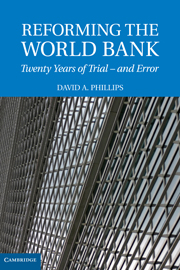Book contents
- Frontmatter
- Contents
- Preface: The Search for Effectiveness in the World's Premier Development Institution
- REFORMING THE WORLD BANK
- PART I ORIGINS AND EVOLUTION
- PART II THE SEARCH FOR EFFECTIVENESS
- 3 Fifty Years of Bank Reforms
- 4 The 1990s – Re-Engineering the Organization
- 5 Changing Culture and Changing People
- 6 Reforming the Bank's Assistance Product
- 7 Changing the Quality of Development Assistance
- 8 Financing the Reorganization
- 9 Why Did the Reforms Fail?
- PART III TOWARDS REAL REFORM: THE GOVERNANCE AGENDA
- Index
3 - Fifty Years of Bank Reforms
Published online by Cambridge University Press: 25 January 2011
- Frontmatter
- Contents
- Preface: The Search for Effectiveness in the World's Premier Development Institution
- REFORMING THE WORLD BANK
- PART I ORIGINS AND EVOLUTION
- PART II THE SEARCH FOR EFFECTIVENESS
- 3 Fifty Years of Bank Reforms
- 4 The 1990s – Re-Engineering the Organization
- 5 Changing Culture and Changing People
- 6 Reforming the Bank's Assistance Product
- 7 Changing the Quality of Development Assistance
- 8 Financing the Reorganization
- 9 Why Did the Reforms Fail?
- PART III TOWARDS REAL REFORM: THE GOVERNANCE AGENDA
- Index
Summary
EARLY CHANGES
While the 1990s reforms are the major interest here, they were not the first. The Bank has gone through a number of reorganizations, from top management reshuffles and shifts in organizational emphasis to root-and-branch restructuring and re-engineering.
The first reorganization, of the IBRD, was in 1952. As the institution expanded, President Eugene Black found it necessary to regionalize operations, supported by a central projects department. In 1972 there was a more thoroughgoing reorganization. Using his experience at the Ford Motor Company, Robert McNamara introduced planning and financial control, an audit committee of the directors and an internal auditor. He set up an operational evaluation unit that was later, in 1973, renamed the Operations Evaluation Department (OED) reporting directly to the board of directors. He decentralized further to the regions, and country program plans were introduced as a focus for lending. The purpose of decentralization in McNamara's conception was to develop a ‘creative tension’ between country programs (oriented toward country monitoring and macroeconomic support) and country projects (oriented toward specific operations on the ground). This was an idea that foreshadowed much more complicated later initiatives. McNamara aggressively expanded the institution's role and capacity within this framework, and the subsequent history of the Bank has in some sense been a reaction to his initiatives.
After McNamara left the post the Bank entered a period starting with President Tom Clausen (1981–1986) during which it was less closely managed and became increasingly vulnerable to outside criticism and increasingly subject to a confrontational economic orthodoxy, discussed later.
- Type
- Chapter
- Information
- Reforming the World BankTwenty Years of Trial - and Error, pp. 45 - 57Publisher: Cambridge University PressPrint publication year: 2009

